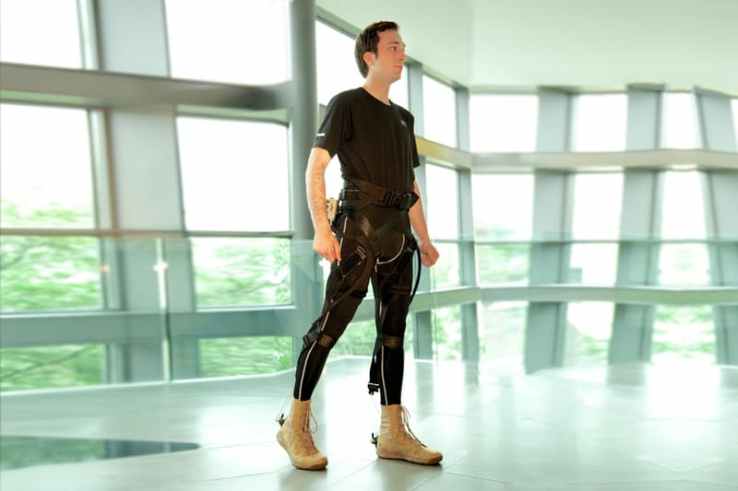Ask your doctor how this compares to these 4 posts on soft exosuit, and these 5 posts on soft robotics.
Your doctor not knowing one damn thing about any of these is worth a call to the hospital president asking why such incompetency is allowed. Not knowing this stuff means your doctor is coasting thru their job rather than keeping up-to-date.
Rewalk Robotics is building a “soft exoskeleton” to rehabilitate stroke patients
 The Boston-based company that was first to provide robotic legs to
paralyzed veterans in the U.S., Rewalk Robotics Ltd., has a new product
in development that you won’t see this week at CES. The device is a
“soft exoskeleton,” designed to help people who have lower limb
disability but who have not severed their spinal cord or otherwise
become paraplegic.
The Boston-based company that was first to provide robotic legs to
paralyzed veterans in the U.S., Rewalk Robotics Ltd., has a new product
in development that you won’t see this week at CES. The device is a
“soft exoskeleton,” designed to help people who have lower limb
disability but who have not severed their spinal cord or otherwise
become paraplegic.According to Rewalk CEO Larry Jasinski, “Many people who have had a stroke can stand up but cannot lift their feet well or cannot put their legs down or propel the leg on their own to walk. If you could help them move their legs, but not have to put a big structure around them, it would be a very attractive option.”
The new product will help Rewalk broaden its market, addressing patients recovering from a stroke, or dealing with everything from the effects of old age to diseases that impair their mobility like MS and Parkinson’s disease. The soft exoskeleton could be utilized by these patients, either long-term or as part of a rehab process.
Today, Rewalk’s soft exoskeleton prototype looks more like something a rock climber might wear than Transformer parts. Its main elements are: a belt and fanny pack with motors and a computer within, cables that extend down the legs, knee braces to keep them in place and sensor-laden footplates that can fit into a sneaker or other soft shoe.
The waist belt weighs about eight pounds and the cables, braces and footplates add about two more pounds to the total weight, at this point. Rewalk acquired the initial technology design from the Wyss Institute at Harvard, which had begun developing a “biologically inspired smart suit,” the Medexo, with funding from the U.S. Defense Advanced Research Projects Agency (DARPA) back in 2014. DARPA has long had an interest in technology that can be applied to help soldiers or medics walk farther, or for longer, and carry more weight in the field.
Jasinski tells TechCrunch that one reason for the tech transfer deal was that Harvard researchers had a great design, but needed to marry it with expertise around motors, gears and software to make it work in the real world. Rewalk had done all that with its earlier systems, and had also figured out how to work with the FDA and the VA to get its devices approved for veteran benefits reimbursements.
Here’s how the new technology helps a patient to walk on their own, Jasinski explained: “Think about a bicycle. You have cables that transfer force down a line to close a brake down on the bike’s tires. This uses the same principal but is obviously more complex. One cable runs along the outside part on the front of your leg and another on the back. The motor and gear are on your waist attached to the cables. A lightweight brace worn on your calf keeps the cables in place. The computer and our software will tell the motor to turn just enough to lift the cable, pull it and get you ground clearance, then propel your foot forward. Sensors in a footplate in your shoe send data to the computer to let it know everything about your position and when you are walking.”
Rewalk will begin clinical studies of its soft exoskeletons in the back half of 2017. The company seeks to make the device available in 2018, pending FDA approvals. The soft exoskeleton will initially have power sufficient to move the legs, or be constantly walking, for two hours at a stretch.
The company will seek distribution again through the VA health system and private sector rehab centers that already pay for “gait training” systems for stroke patients. Later, the product could be adapted for those with diseases like MS, which strikes more women than men and usually is diagnosed in a person’s late 20s or early 30s, or Parkinson’s.
“If you had a stroke, and you were laying in a hospital bed for 10 days, theoretically you could lose 10% to 20% of your muscle mass,” Jasinski said. If you could use this in recovery, you’d have a much better chance at regaining your mobility in full is the hope. With MS and Parkinson’s we think about using this to walk more, and put off later-stage developments.”
Featured Image: rewalk.com
I am also suspicious whenever I see a able-bodied person modeling the device.
ReplyDelete